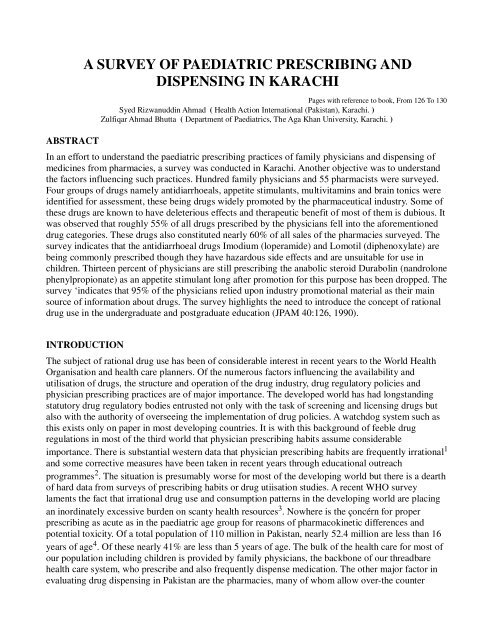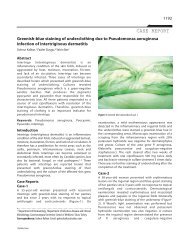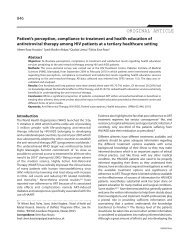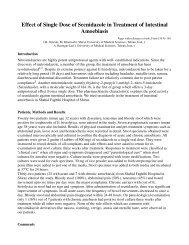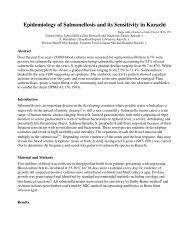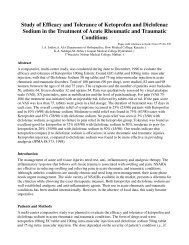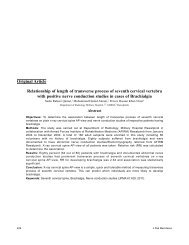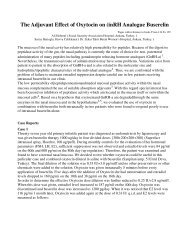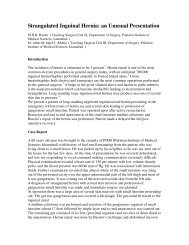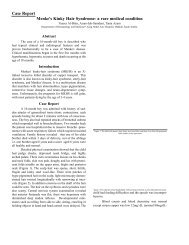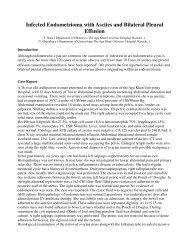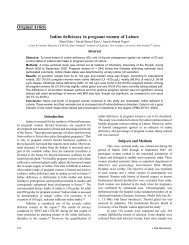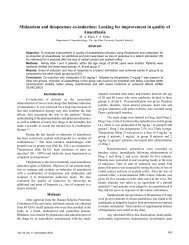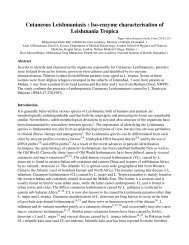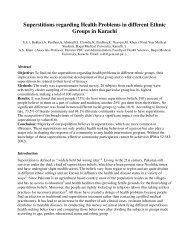a survey of paediatric prescribing and dispensing in karachi
a survey of paediatric prescribing and dispensing in karachi
a survey of paediatric prescribing and dispensing in karachi
You also want an ePaper? Increase the reach of your titles
YUMPU automatically turns print PDFs into web optimized ePapers that Google loves.
ABSTRACT<br />
A SURVEY OF PAEDIATRIC PRESCRIBING AND<br />
DISPENSING IN KARACHI<br />
Pages with reference to book, From 126 To 130<br />
Syed Rizwanudd<strong>in</strong> Ahmad ( Health Action International (Pakistan), Karachi. )<br />
Zulfiqar Ahmad Bhutta ( Department <strong>of</strong> Paediatrics, The Aga Khan University, Karachi. )<br />
In an effort to underst<strong>and</strong> the <strong>paediatric</strong> <strong>prescrib<strong>in</strong>g</strong> practices <strong>of</strong> family physicians <strong>and</strong> <strong>dispens<strong>in</strong>g</strong> <strong>of</strong><br />
medic<strong>in</strong>es from pharmacies, a <strong>survey</strong> was conducted <strong>in</strong> Karachi. Another objective was to underst<strong>and</strong><br />
the factors <strong>in</strong>fluenc<strong>in</strong>g such practices. Hundred family physicians <strong>and</strong> 55 pharmacists were <strong>survey</strong>ed.<br />
Four groups <strong>of</strong> drugs namely antidiarrhoeals, appetite stimulants, multivitam<strong>in</strong>s <strong>and</strong> bra<strong>in</strong> tonics were<br />
identified for assessment, these be<strong>in</strong>g drugs widely promoted by the pharmaceutical <strong>in</strong>dustry. Some <strong>of</strong><br />
these drugs are known to have deleterious effects <strong>and</strong> therapeutic benefit <strong>of</strong> most <strong>of</strong> them is dubious. It<br />
was observed that roughly 55% <strong>of</strong> all drugs prescribed by the physicians fell <strong>in</strong>to the aforementioned<br />
drug categories. These drugs also constituted nearly 60% <strong>of</strong> all sales <strong>of</strong> the pharmacies <strong>survey</strong>ed. The<br />
<strong>survey</strong> <strong>in</strong>dicates that the antidiarrhoeal drugs Imodium (loperamide) <strong>and</strong> Lomotil (diphenoxylate) are<br />
be<strong>in</strong>g commonly prescribed though they have hazardous side effects <strong>and</strong> are unsuitable for use <strong>in</strong><br />
children. Thirteen percent <strong>of</strong> physicians are still <strong>prescrib<strong>in</strong>g</strong> the anabolic steroid Durabol<strong>in</strong> (n<strong>and</strong>rolone<br />
phenylpropionate) as an appetite stimulant long after promotion for this purpose has been dropped. The<br />
<strong>survey</strong> ‘<strong>in</strong>dicates that 95% <strong>of</strong> the physicians relied upon <strong>in</strong>dustry promotional material as their ma<strong>in</strong><br />
source <strong>of</strong> <strong>in</strong>formation about drugs. The <strong>survey</strong> highlights the need to <strong>in</strong>troduce the concept <strong>of</strong> rational<br />
drug use <strong>in</strong> the undergraduate <strong>and</strong> postgraduate education (JPAM 40:126, 1990).<br />
INTRODUCTION<br />
The subject <strong>of</strong> rational drug use has been <strong>of</strong> considerable <strong>in</strong>terest <strong>in</strong> recent years to the World Health<br />
Organisation <strong>and</strong> health care planners. Of the numerous factors <strong>in</strong>fluenc<strong>in</strong>g the availability <strong>and</strong><br />
utilisation <strong>of</strong> drugs, the structure <strong>and</strong> operation <strong>of</strong> the drug <strong>in</strong>dustry, drug regulatory policies <strong>and</strong><br />
physician <strong>prescrib<strong>in</strong>g</strong> practices are <strong>of</strong> major importance. The developed world has had longst<strong>and</strong><strong>in</strong>g<br />
statutory drug regulatory bodies entrusted not only with the task <strong>of</strong> screen<strong>in</strong>g <strong>and</strong> licens<strong>in</strong>g drugs but<br />
also with the authority <strong>of</strong> oversee<strong>in</strong>g the implementation <strong>of</strong> drug policies. A watchdog system such as<br />
this exists only on paper <strong>in</strong> most develop<strong>in</strong>g countries. It is with this background <strong>of</strong> feeble drug<br />
regulations <strong>in</strong> most <strong>of</strong> the third world that physician <strong>prescrib<strong>in</strong>g</strong> habits assume considerable<br />
importance. There is substantial western data that physician <strong>prescrib<strong>in</strong>g</strong> habits are frequently irrational 1<br />
<strong>and</strong> some corrective measures have been taken <strong>in</strong> recent years through educational outreach<br />
programmes 2 . The situation is presumably worse for most <strong>of</strong> the develop<strong>in</strong>g world but there is a dearth<br />
<strong>of</strong> hard data from <strong>survey</strong>s <strong>of</strong> <strong>prescrib<strong>in</strong>g</strong> habits or drug utiisation studies. A recent WHO <strong>survey</strong><br />
laments the fact that irrational drug use <strong>and</strong> consumption patterns <strong>in</strong> the develop<strong>in</strong>g world are plac<strong>in</strong>g<br />
an <strong>in</strong>ord<strong>in</strong>ately excessive burden on scanty health resources 3 . Nowhere is the çoncérn for proper<br />
<strong>prescrib<strong>in</strong>g</strong> as acute as <strong>in</strong> the <strong>paediatric</strong> age group for reasons <strong>of</strong> pharmacok<strong>in</strong>etic differences <strong>and</strong><br />
potential toxicity. Of a total population <strong>of</strong> 110 million <strong>in</strong> Pakistan, nearly 52.4 million are less than 16<br />
years <strong>of</strong> age 4 . Of these nearly 41% are less than 5 years <strong>of</strong> age. The bulk <strong>of</strong> the health care for most <strong>of</strong><br />
our population <strong>in</strong>clud<strong>in</strong>g children is provided by family physicians, the backbone <strong>of</strong> our threadbare<br />
health care system, who prescribe <strong>and</strong> also frequently dispense medication. The other major factor <strong>in</strong><br />
evaluat<strong>in</strong>g drug <strong>dispens<strong>in</strong>g</strong> <strong>in</strong> Pakistan are the pharmacies, many <strong>of</strong> whom allow over-the counter
(OTC) sale <strong>of</strong> most drugs. Although regulations require that a qualified pharmacist be employed <strong>in</strong><br />
each pharmacy, <strong>in</strong> practice this is frequently flaunted. This is particularly true where medical <strong>and</strong><br />
general supplies are sold under the same ro<strong>of</strong>. In an effort to underst<strong>and</strong> the <strong>paediatric</strong> <strong>prescrib<strong>in</strong>g</strong><br />
practices <strong>of</strong> family physicians <strong>and</strong> the <strong>dispens<strong>in</strong>g</strong> <strong>of</strong> medic<strong>in</strong>es from pharmacies, we undertook a<br />
<strong>survey</strong> <strong>in</strong> Karachi. An additional objective was to underst<strong>and</strong> the factors <strong>in</strong>fluenc<strong>in</strong>g such <strong>prescrib<strong>in</strong>g</strong><br />
practices.<br />
METHODOLOGY<br />
Four target groups <strong>of</strong> thugs were identified for assessment.<br />
1. Antidiarrhoeals<br />
2. Appetite-stimulants<br />
3. Multivitam<strong>in</strong>s<br />
4. Bra<strong>in</strong> tonics<br />
These drugs were selected as they are widely promoted by the pharmaceutical <strong>in</strong>dustry, ma<strong>in</strong>ly for the<br />
<strong>paediatric</strong> age group <strong>and</strong> are largely imported <strong>in</strong> the raw or prepared form. The <strong>survey</strong> was conducted<br />
<strong>in</strong> three <strong>of</strong> the five districts <strong>of</strong> Karachi (District North, West <strong>and</strong> Central). The areas selected were those<br />
with a wide mixture <strong>of</strong> lower <strong>and</strong> middle socioeconomic groups. In all areas family physicians with a<br />
substantial <strong>paediatric</strong> practice (40% or more) were identified by a prelim<strong>in</strong>ary <strong>survey</strong>. Correspond<strong>in</strong>g<br />
pharmacies cater<strong>in</strong>g to these physician practices were also identified for <strong>survey</strong>. The <strong>survey</strong> was<br />
conducted over an 8 week period (May-June 1988) by a team <strong>of</strong> two doctors <strong>and</strong> a pharmacist by<br />
means <strong>of</strong> an <strong>in</strong>terview us<strong>in</strong>g a predesigned questionnaire. Most questions were <strong>of</strong> the closed variety<br />
requir<strong>in</strong>g s<strong>in</strong>gle choice answers. Commonly prescribed drug br<strong>and</strong>s <strong>in</strong> different categories were rank<br />
ordered by the family practitioners <strong>and</strong> pharmacists from a comprehensive preselected list. We did not<br />
attempt to do a prescription analysis <strong>and</strong> the physicians <strong>and</strong> pharmacists were assured <strong>of</strong> the utmost<br />
confidentiality <strong>of</strong> their identity <strong>in</strong> the <strong>survey</strong>.<br />
RESULTS<br />
A total <strong>of</strong> 100 family physicians <strong>and</strong> 55 pharmacists agreed to participate <strong>in</strong> the <strong>survey</strong>. Most <strong>of</strong> the<br />
family physicians had busy practices, see<strong>in</strong>g an average <strong>of</strong> 60 patients per day, <strong>of</strong> whom children<br />
constituted 48% on an average.<br />
Table 1 shows the physician responses to questions on commonly prescribed drug categories whereas<br />
the correspond<strong>in</strong>g sales categories <strong>of</strong> drugs are given <strong>in</strong> Table II.
It can be estimated that roughly 55% <strong>of</strong> all drugs prescribed by the physicians fell <strong>in</strong>to the category <strong>of</strong><br />
vitam<strong>in</strong>s, appetite-stimulants <strong>and</strong> bra<strong>in</strong>- tonics whereas 45% <strong>of</strong> all children with diarrhoea were<br />
prescribed antidiarrhoeals. These drugs also constituted nearly 60% <strong>of</strong> all sales <strong>of</strong> the pharmacies<br />
<strong>survey</strong>ed. Overall nearly 40% <strong>of</strong> all sales <strong>of</strong> these drugs were over-the-counter.
Tables III, IV <strong>and</strong> V show the commonly prescribed br<strong>and</strong>s <strong>of</strong> appetite stimulants, vitam<strong>in</strong>s <strong>and</strong> bra<strong>in</strong>tonics<br />
along with the estimated daily cost <strong>of</strong> therapy <strong>and</strong> the various reasons cited for prescription.
Table VI lists the commonly prescribed antidiarrhoeals <strong>in</strong> rank order along with the daily cost <strong>of</strong><br />
therapy. On question<strong>in</strong>g, only 63% <strong>of</strong> physicians confessed to knowledge <strong>of</strong> the exact cost <strong>of</strong> drugs<br />
prescribed <strong>and</strong> 28% categorically stated that the patient’s economic condition was not taken <strong>in</strong>to<br />
account when <strong>prescrib<strong>in</strong>g</strong>.
Table VII lists the various sources <strong>of</strong> <strong>in</strong>formation cited by the family physicians <strong>in</strong> their knowledge <strong>of</strong><br />
different drugs prescribed. In Tables III, IV, V, VI <strong>and</strong> VII percentages total more than 100 s<strong>in</strong>ce<br />
physicians gave more than one response. Table VII lists the factors <strong>in</strong>fluenc<strong>in</strong>g drug selection by<br />
pharmacists. Percentages total more than 100 <strong>in</strong> Table VII s<strong>in</strong>ce pharmacists gave more than one<br />
response.<br />
DISCUSSION<br />
Our study was designed to look at a cross section <strong>of</strong> busy family physicians <strong>in</strong> an effort to assess their<br />
perceptions <strong>and</strong> <strong>prescrib<strong>in</strong>g</strong> practices especially <strong>in</strong> relation to the aforementioned four drug categories.<br />
Information was also obta<strong>in</strong>ed from correspond<strong>in</strong>g pharmacies <strong>in</strong> an effort to cross check <strong>prescrib<strong>in</strong>g</strong><br />
practices. In most cases there was close correlation between the two. We chose to select these<br />
categories <strong>of</strong> drugs for multiple reasons. Some are known to have deleterious effects <strong>and</strong> the<br />
therapeuticbenefit <strong>of</strong> most <strong>of</strong> them is at best dubious. There are currently 9500 registered drugs <strong>in</strong><br />
Pakistan <strong>of</strong> which 6500 are formulated locally while 3000 are imported. The raw material for the<br />
production <strong>of</strong> many <strong>of</strong> these pharmaceuticals is ma<strong>in</strong>ly imported at a heavy cost to the national<br />
exchequer. The local pharmaceutical market is estimated to be <strong>in</strong> the region <strong>of</strong> Rs. 7 billion annually. It<br />
is disconcert<strong>in</strong>g to note the high rate <strong>of</strong> prescription <strong>and</strong> <strong>dispens<strong>in</strong>g</strong> <strong>of</strong> multivitam<strong>in</strong>s <strong>and</strong> appetite<br />
stimulants, s<strong>in</strong>ce these drugs have a very limited role <strong>in</strong> the nutritional rehabilitation <strong>of</strong> children, the<br />
commonest cause for which <strong>in</strong> Pakistan is prote<strong>in</strong> energy malnutrition. A poor family expend<strong>in</strong>g a large<br />
proportion <strong>of</strong> its drug bills on expensive multivitam<strong>in</strong> preparationsis better advised to divert its<br />
resources to basic needs. The so-called ‘bra<strong>in</strong>tonics’ also fall <strong>in</strong>to the same category. On the basis <strong>of</strong><br />
our data it is clear that a substantial number <strong>of</strong> these drugs prescribed <strong>and</strong> dispensed are non-essential,<br />
<strong>in</strong>effective <strong>and</strong> <strong>of</strong> little or no therapeutic value. Some <strong>of</strong> these drugs may be actually hazardous with<br />
significant toxic side effects. Encephabol (Pyrit<strong>in</strong>ol) is associated with significant side effects <strong>in</strong> 25%<br />
<strong>of</strong> patients 5 . Our <strong>survey</strong> <strong>in</strong>dicates that 41% <strong>of</strong> physicians are still <strong>prescrib<strong>in</strong>g</strong> Lomotil (Diphenoxylate)<br />
to children, a drug fraught with hazards <strong>of</strong> overdosage 6 <strong>and</strong> potentially fatal <strong>in</strong> <strong>in</strong>fants 7 . Thirteen (14%)<br />
doctors prescribed Durabol<strong>in</strong> (N<strong>and</strong>rolone pbenylpropionate), an anabolic steroid, as an appetite<br />
stimulant long after promotion for this purpose has been dropped. Anabolic steroids are associated with
a significant risk <strong>of</strong> <strong>and</strong>rogenic side effects, virilization, premature fusion <strong>of</strong> epiphyses 8 <strong>and</strong> have been<br />
implicated <strong>in</strong> a number <strong>of</strong> law suits <strong>in</strong>volv<strong>in</strong>g unethical promotion <strong>and</strong> market<strong>in</strong>g <strong>in</strong> the develop<strong>in</strong>g<br />
world 9 . Of equal concern was the wide variety <strong>of</strong> responses obta<strong>in</strong>ed as to the <strong>in</strong>dications for various<br />
drugs roughly 16-18% <strong>of</strong> different drugs be<strong>in</strong>g prescribed on parental dem<strong>and</strong>. It was apparent that<br />
cost-effectiveness played little or no role <strong>in</strong> drug selection as the ma<strong>in</strong> choices <strong>in</strong> nearly all drug<br />
categories were also the most expensive. Sixty one physicians chose Imodium (Loperamide), which is<br />
expensive <strong>and</strong> unsuitable for children. Imodium toxicity has recently been associated with a number <strong>of</strong><br />
deaths (Bhutta T.I. Personal Communication). The economic <strong>and</strong> ethical implications <strong>of</strong> this issue are<br />
compounded by the observation that physician <strong>prescrib<strong>in</strong>g</strong> practices significantly <strong>in</strong>fluence the way<br />
pharmacists dispense drugs. In our <strong>survey</strong> 82% <strong>of</strong> pharmacists cited physician <strong>prescrib<strong>in</strong>g</strong> practices as<br />
the ma<strong>in</strong> reason for stock selection. It is thus easy to imag<strong>in</strong>e the deleterious effect <strong>of</strong> irrational<br />
<strong>prescrib<strong>in</strong>g</strong> by physicians as it snowballs <strong>in</strong>to subsequent potentially dangerous over-the-counter sales<br />
<strong>in</strong> pharmacies. What are the reasons for these <strong>prescrib<strong>in</strong>g</strong> practices? A close look at the way drugrelated<br />
<strong>in</strong>formation is conveyed to our physicians provides clear answers. Our medical school <strong>and</strong><br />
pharmacology curricula provide only limited <strong>in</strong>formation on <strong>prescrib<strong>in</strong>g</strong> to the young doctor who is<br />
then left to fend for himself <strong>in</strong> the “real world” with non-generic formulations <strong>and</strong> only the omnipresent<br />
pharmaceutical representative to guide him. It is hardly surpris<strong>in</strong>g therefore that 95% <strong>of</strong> the physicians<br />
<strong>in</strong> our <strong>survey</strong> relied upon medical representatives <strong>and</strong> promotional material as the ma<strong>in</strong> source <strong>of</strong><br />
<strong>in</strong>formation. Very few utilized st<strong>and</strong>ard <strong>prescrib<strong>in</strong>g</strong> guides <strong>and</strong> medical conferences <strong>and</strong> there was<br />
<strong>in</strong>significant access to any other academic source. The heavy reliance on the pharmaceutical <strong>in</strong>dustry’s<br />
promotional material as a source <strong>of</strong> <strong>in</strong>formation is a major cause for concern. Most <strong>of</strong> the promotional<br />
material provides limited, <strong>in</strong>complete <strong>and</strong> occasionally mislead<strong>in</strong>g <strong>in</strong>formation. Our <strong>survey</strong> highlights<br />
the urgent need for concerted measures <strong>in</strong> an effort to improve <strong>paediatric</strong> <strong>prescrib<strong>in</strong>g</strong> <strong>and</strong> <strong>dispens<strong>in</strong>g</strong> <strong>of</strong><br />
drugs. While the problem is clearly multifactor <strong>and</strong> there is no easy solution, yet there is considerable<br />
scope for improvement. First <strong>and</strong> foremost, we <strong>in</strong> the medical pr<strong>of</strong>ession need to accept that there is a<br />
real problem. Such problems are not unique to Pakistan but are a consequence <strong>of</strong> mult<strong>in</strong>ational<br />
market<strong>in</strong>g <strong>and</strong> promotional strategies 10 together with <strong>in</strong>adequate attention to the tra<strong>in</strong><strong>in</strong>g <strong>of</strong> prescribers<br />
both <strong>in</strong> undergraduate <strong>and</strong> postgraduate education. With such a large proportion <strong>of</strong> our population<br />
fall<strong>in</strong>g <strong>in</strong> the <strong>paediatric</strong> age group, there is an urgent need to devote a greater share <strong>of</strong> undergraduate<br />
medical curricula to the teach<strong>in</strong>g <strong>of</strong> cl<strong>in</strong>ical <strong>and</strong> primary care <strong>paediatric</strong>s. While it is important to<br />
impart knowledge <strong>of</strong> pathophysiology, clear <strong>and</strong> concise management guidel<strong>in</strong>es <strong>and</strong> therapy must be<br />
taught. The concept <strong>of</strong> essential drug use especially <strong>in</strong> the context <strong>of</strong> the develop<strong>in</strong>g world, is now well<br />
established 11 <strong>and</strong> should be <strong>in</strong>cluded <strong>in</strong> any national drugs programme 12 . Such concepts <strong>of</strong> essential<br />
drug use <strong>and</strong> rational drug <strong>prescrib<strong>in</strong>g</strong> should be <strong>in</strong>troduced <strong>in</strong>to medical curricula at an early stage <strong>and</strong><br />
constantly strengthened by reiteration throughout the cl<strong>in</strong>ical curriculum 13,14 . A step <strong>in</strong> the right<br />
direction would be the sett<strong>in</strong>g up <strong>of</strong> departments <strong>of</strong> cl<strong>in</strong>ical pharmacology <strong>in</strong> teach<strong>in</strong>g hospitals to help<br />
improve <strong>prescrib<strong>in</strong>g</strong> practices <strong>and</strong> safety 15 . In our op<strong>in</strong>ion the doctors <strong>of</strong> the future should also be<br />
<strong>in</strong>troduced to the concept <strong>of</strong> drug economics <strong>and</strong> <strong>in</strong>structed <strong>in</strong> the ‘art’ <strong>of</strong> objectively analys<strong>in</strong>g drug<br />
promotional material It is imperative that an effective system <strong>of</strong> cont<strong>in</strong>u<strong>in</strong>g medical education (CME)<br />
for primary care physicians be <strong>in</strong>troduced. Currently, the only source <strong>of</strong> cont<strong>in</strong>u<strong>in</strong>g education for<br />
primary care physicians, other than drug promotional material are the <strong>in</strong>dustry sponsored publications.<br />
Most <strong>of</strong> these are naturally geared to <strong>in</strong>dustry market<strong>in</strong>g strategies <strong>and</strong> objectives. The only suitable<br />
countermeasure is an effective educational outreach programme for physicians 16,17 or <strong>in</strong> some<br />
<strong>in</strong>stances even an educational advertis<strong>in</strong>g campaign 18 . Such strategies have been suceessful <strong>in</strong> some<br />
developed countries <strong>and</strong> are cost-effective 19 . In Pakistan, this role needs to be taken up by our<br />
Universities, the College <strong>of</strong> Family Physicians <strong>and</strong> postgraduate medical <strong>in</strong>stitutions, who should<br />
provide regular CME programmes. The College <strong>of</strong> Family Physicians should consider mak<strong>in</strong>g
participation <strong>in</strong> such CME activities m<strong>and</strong>atory for its members. F<strong>in</strong>ally but perhaps most importantly,<br />
a vital requirement for most national drug policies <strong>and</strong> rational drug use campaigns is the political will<br />
<strong>of</strong> the government 20 . A government eommitted to an essential drugs <strong>and</strong> rational drug use programme<br />
should also streaml<strong>in</strong>e its regulatory <strong>and</strong> watchdog bodies, <strong>and</strong> keep a strict control on drug advertis<strong>in</strong>g<br />
<strong>and</strong> market<strong>in</strong>g. Many countries have benefited from adopt<strong>in</strong>g an essential drugs policy <strong>and</strong> programmes<br />
21 . An example is that <strong>of</strong> Bangladesh, a country racked with poverty which took the decision’ to<br />
implement a national essential drug policy <strong>in</strong> 1982. Despite <strong>in</strong>itial opposition, Bangladesh had the<br />
political will to see the policy through <strong>and</strong> now has access to a three folds greater the quantity <strong>of</strong> the<br />
most essential drugs at substantially lower prices than before 22 .<br />
ACKNOWLEDGEMENTS<br />
This project has been funded by a grant from the UNICEF Regional <strong>of</strong>fice, Bangkok, Thail<strong>and</strong>, adm<strong>in</strong>istered<br />
through the International Organisation <strong>of</strong> Consumers’ Unions (IOCU), Regional <strong>of</strong>fice for<br />
Asia <strong>and</strong> the Pacific, Penang, Malaysia. Prelim<strong>in</strong>ary f<strong>in</strong>d<strong>in</strong>gs <strong>of</strong> this study were presented at an<br />
International Consultation on Children’s medic<strong>in</strong>es held <strong>in</strong> Manila, the Philipp<strong>in</strong>es, <strong>in</strong> August 1988.<br />
REFERENCES<br />
1. Harvey, K.. Antibiotic use <strong>in</strong> Australia. Australian Prescriber, 1988;11:74.<br />
2. Avorn, J., Harvey, K., Soumerai, S.B., Herxheimer, A., Plumridge, It <strong>and</strong> Bardelay, G. Information<br />
<strong>and</strong> education as determ<strong>in</strong>ants <strong>of</strong> antibiotic use: report <strong>of</strong> Task Force 5. Rev. Infect. Dis., 1987; 9<br />
(Suppl) 3:5286.<br />
3. World Health Organisation. The World Drug Situation. Geneva, WHO, 1988, p.7.<br />
4. UNICEF. The state <strong>of</strong> the world’s children 1989. Oxford, Oxford University Press, 1989, p. 102.<br />
5. Dukes, M.N.G. Meyler’s side effects <strong>of</strong> drugs. 11th ed. Amsterdam, Elsevier Amsterdam, 1988, p.<br />
192.<br />
6. Mart<strong>in</strong>dale; W. The extra pharmacopoeia, 29th ed. London. The Pharmaceutical Press, 1989, p. 1087.<br />
7. World Health Organization.The treatment <strong>and</strong> prevention <strong>of</strong> acute diarrhea-practical guidel<strong>in</strong>es, 2nd<br />
ed. WHO., Geneva, 1989, p.4.<br />
8. Oilman, A.G., Goodman, LS., Ball, T.W. <strong>and</strong> Murad, F. The pharmacological basis <strong>of</strong> therapeutics.<br />
7th ed. London, Macmillan, 1985, p. 1447;<br />
9. IFPMA. IFPMA code <strong>of</strong> pharmaceutical market<strong>in</strong>g practice: status report March 1984, Geneva, April<br />
1984, p.3.<br />
10. Summary conclusions <strong>of</strong> Dag Hammarskjold sem<strong>in</strong>ar on “Another development <strong>in</strong><br />
Pharmaceuticals”, Uppsala, Sweden,June 3-6,1985, Development Dialogue, 1985; 2: 134.<br />
11. World Health Organization. The use <strong>of</strong> essential drugs. Third report <strong>of</strong> the WHO expert committee.<br />
Geneva, WHO, 1988.<br />
12. World Health Organization. The rational use <strong>of</strong> drugs. Report <strong>of</strong> the conference <strong>of</strong> experts<br />
November1985, Nairobi. Geneva, WHO, 1987.<br />
13. World Health Organization. Report <strong>of</strong> an <strong>in</strong>formal meet<strong>in</strong>g on <strong>in</strong>troduc<strong>in</strong>g the essential drug<br />
concept <strong>in</strong> curricula <strong>of</strong> Universities <strong>and</strong> other teach<strong>in</strong>g <strong>in</strong>stitutions. Geneva, WHO, 1984.<br />
14. World Health Organization. Proceed<strong>in</strong>gs <strong>of</strong> the workshop on the essential drugconcept <strong>and</strong> the role<br />
<strong>of</strong> medical schools <strong>in</strong> itsdissem<strong>in</strong>ation. Dar- es-Salaam, Tanzania, WHO, 1986.<br />
15. WHO work<strong>in</strong>g group on cl<strong>in</strong>ical pharmacology <strong>in</strong> Europe. Q<strong>in</strong>ical Pharmacology <strong>in</strong> Europe: an<br />
<strong>in</strong>dispensible part <strong>of</strong> the health service. Eur. J. Cl<strong>in</strong>. Pharmacol., 1988; 33:535.<br />
16. Avorn, J. <strong>and</strong> Soumerai, S.D. Improv<strong>in</strong>g drug-therapy decisions through educational outreach. A<br />
r<strong>and</strong>omized controlled trial <strong>of</strong> academically based “detail<strong>in</strong>g”. N. Engl. LI. Med., 1983; 308:1457-
1463.<br />
17. Schaffner, W., Ray, WA., Federspeil, C.F. <strong>and</strong> Miller, W.O. Improv<strong>in</strong>g antibiotic <strong>prescrib<strong>in</strong>g</strong> <strong>in</strong><br />
<strong>of</strong>fice practice; a controlled trial <strong>of</strong> three educational methods. JAMA., 1983; 250:1728.<br />
18. Harvey, K.J., Stewart, It, Hemm<strong>in</strong>g, M., Naismith, N. <strong>and</strong> Moulds, R.F.W. Educational antibiotic<br />
advertis<strong>in</strong>g. Med. 3. Aust., 1986; 145:28.<br />
19. Soumerai, S.D. <strong>and</strong> Avon, J. Economic <strong>and</strong> policy analysis <strong>of</strong> University-based drug “detail<strong>in</strong>g”.<br />
Med. Care, 1986; 24: 313.<br />
20. World Health Organization. Guidel<strong>in</strong>es for develop<strong>in</strong>g national drug policies. Geneva, WHO, 1988,<br />
p.3.<br />
21. World Health Organization. The World Drug situation, Geneva, WHO, 1988.<br />
22. Tiranti, DJ. Essential drugs. The Bangladesh example - four years on, 1982-86. Oxford, New<br />
Internationalist Publications, 1986, p.9.


